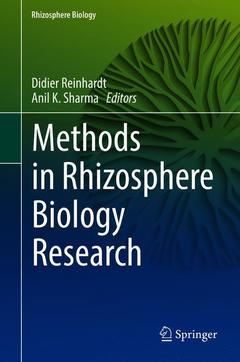Methods in Rhizosphere Biology Research, 1st ed. 2019 Rhizosphere Biology Series
Coordonnateurs : Reinhardt Didier, Sharma Anil K.

Part I: Root symbioses.- Chapter 1. Synthetic plasmids to challenge symbiotic nitrogen fixation between rhizobia and legumes.- Chapter 2. In vivo analysis of rhizosphere enzyme activities by the use of plastic syringes.- Chapter 3. Characterization of arbuscular mycorrhizal communities in roots of vineyard plants.- Chapter 4. Molecular methods for research on actinorhiza.- Chapter 5. Molecular and functional characterization of beneficial bacteria associated with AMF spores.- Part II: Plant pathogens and microbial plant protection.- Chapter 6. Oomycete-root interactions.- Chapter 7. Exploitation of rhizosphere microbiome services.- Chapter 8. Methods for detecting biocontrol and plant growth-promoting traits in rhizobacteria.- Chapter 9. A split-root method to study systemic and heritable traits induced by Trichoderma intomato plants.- Part III: Experimental approaches and analytical techniques in rhizosphere biology.- Chapter 10. Using a tri-isotope (13C, 15N, 33P) labelling method to quantify rhizodeposition.- Chapter 11. Microscopic techniques coupled to molecular and genetic approaches to highlight cell-type specific differences in mycorrhizal symbiosis.- Chapter 12. From imaging to functional traits in interactions between roots and microbes.- Chapter 13. Live imaging of arbuscular mycorrhizal symbiosis.- Chapter 14. Microcosm approaches to investigate multitrophic interactions in microbial communities.- Chapter 15. Analysis of common mycorrhizal networks in microcosms.
Date de parution : 04-2019
Ouvrage de 279 p.
15.5x23.5 cm
Thèmes de Methods in Rhizosphere Biology Research :
Mots-clés :
Rhizosphere; Techniques; Root microbiome; plant-pathogen; soil biology; Soil biology methods



